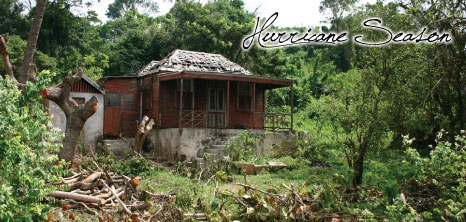|
Hurricane SeasonThe hurricane season in Barbados is from the month of June through to the month of November. During this season the island can experience tropical storm activity accompanied by thunder, lightning and gusty winds. Though Barbados is very much in the hurricane belt, the island has been spared the full fury of most systems passing by in recent years with the last set of destruction and element of surprise coming from Tropical Storm Tomas that passed by at the very end of the hurricane season on October 29th, 2010.
Flooding in low-lying areas is quite prevalent on the island of Barbados during the hurricane season. Despite this challenge, the Government of Barbados has been able to engineer some success with regards to the divertion of flood waters in flood prone areas on the island such as Holetown in the parish of St. James and some areas in Bridgetown. As a matter of great interest, Barbadians are always advised to keep the drains outside their properties clean and clear as this aids in water run off and lessens the chances of flood.
What is a HurricaneA hurricane is a type of tropical cyclone, which is a generic term for a low pressure system that generally forms in the tropics. The cyclone is accompanied by thunderstorms and, in the Northern Hemisphere, a counterclockwise circulation of winds near the earth's surface. Tropical cyclones are classified as follows:
Tropical Depression An organized system of clouds and thunderstorms with a defined surface circulation and maximum sustained winds of 38 mph (33 kt) or less. Sustained winds are a 1-minute average wind measured at about 33 ft (10 meters) above the surface. While 1 knot = 1 nautical mile per hour or 1.15 statute miles per hour and is abbreviated as "kt".
Tropical Storm An organized system of strong thunderstorms with a defined surface circulation and maximum sustained winds of 39-73 mph (34-63 kt).
Hurricane An intense tropical weather system of strong thunderstorms with a well-defined surface circulation and maximum sustained winds of 74 mph (64 kt) or higher. Hurricanes are categorized according to the strength of their winds using the Saffir-Simpson Hurricane Scale. A Category 1 storm has the lowest wind speeds, while a Category 5 hurricane has the strongest. These are relative terms, because lower category storms can sometimes inflict greater damage than higher category storms, depending on where they strike and the particular hazards they bring. In fact, tropical storms can also produce significant damage and loss of life, mainly due to flooding.
Naming HurricanesFor several hundred years, hurricanes in the West Indies were often named after the particular saint's day on which the hurricane occurred. For example "Hurricane San Felipe" struck Puerto Rico on 13 September 1876. Another storm struck Puerto Rico on the same day in 1928, and this storm was named "Hurricane San Felipe the second." Later, latitude-longitude positions were used. However, experience has shown that using distinctive names in communications is quicker and less subject to error than the cumbersome latitude longitude identification methods.
Using women's names became the practice during World War II, following the use of a woman’s name for a storm in the 1941 novel "Storm" by George R. Stewart. In 1951 the United States adopted a confusing plan to name storms by a phonetic alphabet (Able, Baker, Charlie), and in 1953 the nation’s weather services returned to using female names. The practice of using female names exclusively ended in 1978 when names from both genders were used to designate storms in the eastern Pacific. A year later, male and female names were included in lists for the Atlantic and Gulf of Mexico. The name lists, which have been agreed upon at international meetings of the World Meteorological Organization, have a French, Spanish, Dutch, and English flavor because hurricanes affect other nations and are tracked by the public and weather services of many countries.
The Tropical Prediction Center in Miami, FL keeps a constant watch on oceanic storm-breeding grounds. Once a system with counterclockwise circulation and wind speeds of 39 mph or greater is identified, the Center gives the storm a name from the list for the current year. The letters Q, U, X, Y, and Z are not included because of the scarcity of names beginning with those letters. Names associated with storms that have caused significant death and/or damage are usually retired from the list.
Above information on What is a Hurricane and Naming Hurricanes is an extract from http://www.hurricane.com/.
In earlier times, the people of Barbados didn't have the kind of technology that exists today. As a result, there was a famous little rhyme that helped people remember when they needed to brace themselves for possible impact of a storm. It went as follows and still goes today: June too soon, July stand by, August it must, September remember, October all over. It should be noted that as practical as this rhyme may sound, it has deluded the public as past instances have been recorded of some relatively dangerous hurricanes throughout the October and November months. A prime example of this is the great hurricane of October 10, 1780 that killes thousands of people in Barbados and pounded the island for close to fifty (50) hours. October 22, 1955 saw the arrival of Hurricane Janet to the island which claimed more than thirty (30) lives and left more than fifiteen (15) thousand people displaced.
With the meteorological technology that exists on the island today, advance warnings are given in an effort to allow persons enough time to brace themselves for the possible impact of a tropical rainstorm.
|
|
|


